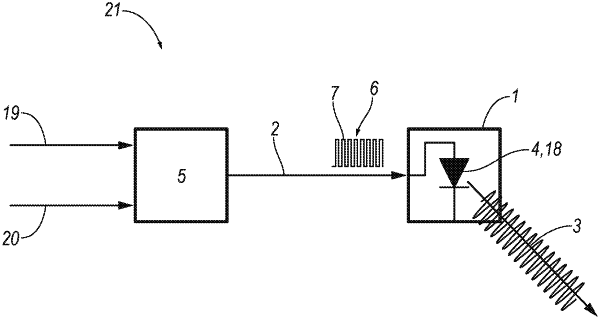| CPC H05B 45/325 (2020.01) [H05B 45/14 (2020.01)] | 6 Claims |

|
1. A method of driving a light source (1) with a control signal (2) wherein an intensity of light (3) emitted by an illuminant (4) depends on a value and a value progression of the control signal (2), the method comprising:
modulating the value progression of the control signal (2) in time with a PWM modulation (6), and either:
(a) determining a duty cycle of the PWM modulation of the control signal driving the light source based on a desired light intensity of the illuminant and determining a PWM period of the modulation of the control signal driving the light source based on the determined PWM modulation, or
(b) determining the period of the PWM modulation of the control signal driving the light source based on a desired light intensity of the illuminant and determining the duty cycle of the control signal driving the light source based on the determined period of the PWM modulation;
wherein:
the PWM modulation (6) of the control signal comprises PWM pulses;
the PWM modulation (6) further comprises PWM periods respectively associated with the PWM pulses;
a PWM period of a respective PWM pulse begins in time with a rising edge of the PWM pulse and ends with a rising edge of an immediately following PWM pulse of the PWM modulation (6);
a PWM pulse instantaneous frequency of the PWM pulse is a reciprocal of the PWM period of the PWM pulse;
a PWM duty cycle of the PWM pulse is a ratio of a value of a temporal duration of the PWM pulse in the PWM period of the PWM modulation of the control signal divided by a value of a temporal PWM period duration of the PWM period of the PWM modulation of the control signal (2),
and further wherein:
an illuminant driver (5) supplies the illuminant (4) with a PWM modulated electric current that is switched on and off according to the PWM modulation of the control signal (2), such that the PWM modulation of the control signal is applied to the illuminant;
the PWM pulse instantaneous frequency of the PWM pulses of the PWM modulation (6) depends on the PWM duty cycle of the PWM pulses of the PWM modulation (6) of the control signal (2);
a PWM pulse instantaneous frequency of PWM pulses of the PWM modulation is a first PWM pulse instantaneous frequency at a first PWM duty cycle of the PWM pulses of the PWM modulation (6) of the control signal (2), and
a PWM pulse instantaneous frequency of the PWM pulses of the PWM modulation (6) at a second PWM duty cycle of the PWM pulses of the PWM modulation (6) of the control signal (2), which is different from the first PWM duty cycle, is a second PWM pulse instantaneous frequency which is different from the first PWM pulse instantaneous frequency;
at least in one operating state, a magnitude of the first PWM duty cycle is smaller than a magnitude of the second PWM duty cycle; and
in the operating state a magnitude of the first PWM pulse instantaneous frequency is smaller than a magnitude of the second PWM pulse instantaneous frequency.
|